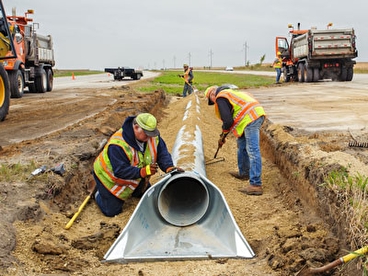Safe and Efficient Tree Removal Providers
Safe and Efficient Tree Removal Providers
Blog Article
Culvert Setup Made Easy: Step-by-Step Overview for Success
Installing culverts may seem like an uncomplicated job, but guaranteeing a successful end result requires mindful planning and implementation. From choosing the ideal culvert size to integrating appropriate drain actions, each action in the setup process plays a critical duty in the performance and durability of the culvert system. By complying with a systematic technique and focusing on vital information, the installation can proceed efficiently, minimizing possible concerns down the line. Keep tuned to reveal the crucial steps and factors to consider that can make culvert installment a smooth and effective undertaking.
Picking the Right Culvert Size
Selecting the proper culvert dimension is essential for making sure efficient water flow and architectural honesty in culvert installation projects - Pad Construction. The dimension of the culvert straight impacts the flow capacity of water with the framework. A culvert that is as well little can cause flooding and overflow, while one that is as well huge might result in reduced water speed, potentially creating sediment accumulation and clogs
To determine the ideal culvert size, factors such as the watershed area, peak flow prices, and hydraulic effectiveness requirement to be very carefully considered. Calculations based upon these criteria help in choosing a size that can appropriately deal with the predicted water volume while decreasing the threat of blockages and architectural failure.
It is necessary to get in touch with engineering standards and standards to guarantee that the chosen culvert dimension meets the task requirements and neighborhood guidelines (Pad Construction). By selecting the appropriate culvert dimension, job supervisors can enhance water circulation, stop potential concerns, and improve the overall performance and durability of the culvert setup
Preparing the Installation Site
Reliable culvert installation requires precise preparation of the setup website to guarantee ideal architectural support and capability. Prior to beginning the setup process, it is important to clear the website of any type of particles, plant life, or blockages that could restrain the culvert's positioning. Making sure a degree foundation is crucial for the appropriate placement and stability of the culvert. This might entail rating the website to develop a smooth, also surface that can effectively support the weight of the culvert and any kind of anticipated lots. In addition, appropriate compaction of the soil underneath the culvert is essential to avoid settling or moving in time.
Moreover, it is very important to think about aspects such as soil composition, groundwater degrees, and environmental influences when preparing the setup site. Conducting a comprehensive site assessment can help determine any type of prospective challenges or risks that may influence the culvert's performance. By taking the time to prepare the installation site properly, you can aid guarantee a successful culvert installation that fulfills structural demands and ensures long-lasting performance.
Putting the Culvert Appropriately

The quality at which the culvert is put is vital for maintaining a proper slope for water circulation. A gradual incline aids stop merging and advertises reliable drain. Additionally, the culvert should be oriented properly to ensure that the inlet and outlet remain in the appropriate areas. This alignment is vital for the culvert to operate successfully in managing water flow.
Backfilling and Compacting the Dirt
Proper backfilling and compaction of the dirt around the culvert is necessary to ensure stability and prevent possible problems in the future. Once the culvert is correctly put, the next crucial step is to backfill the area around it with suitable product.
Compaction assists in decreasing the chances of negotiation and guarantees uniform support around the culvert. It is vital to portable the soil uniformly on all sides of the culvert to preserve its architectural honesty.
Correct backfilling and compaction not only give security to the culvert yet also help in preventing dirt erosion and keeping the longevity of the culvert system.
Guaranteeing Appropriate Drainage Combination
Integrating effective drain solutions plays an important function in the general capability and durability of culvert installations. Proper drain combination is vital for managing water circulation, preventing disintegration, and making certain the architectural stability of the culvert system. To achieve this, it is important to create a comprehensive drainage plan that considers elements such as the quantity of water anticipated, the topography of the location, and the type of dirt existing.

In addition, integrating attributes like disintegration control measures, such as riprap or plant life, can further improve the performance of the drainage system. By carefully intending and implementing these drainage services, culvert setups can work successfully and withstand the test of time.
Final Thought
Finally, correct culvert installment is important for keeping reliable drain systems. By selecting the best culvert size, preparing the installation site, placing the culvert correctly, backfilling and condensing the dirt, and making sure proper drain integration, success can be attained. Complying with these actions will certainly aid guarantee the longevity and performance of the culvert, inevitably contributing to the total success of the drain system.
Report this page